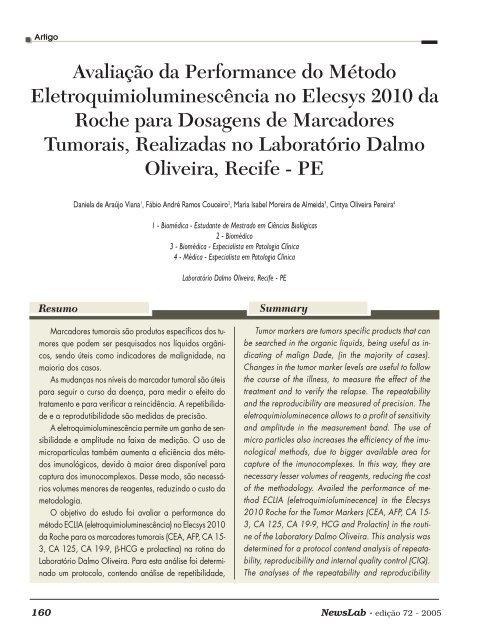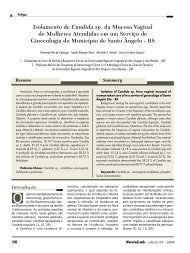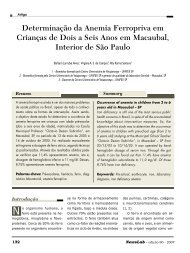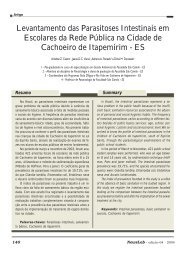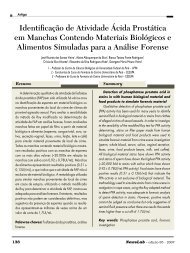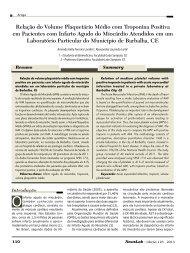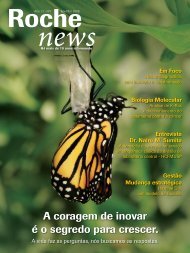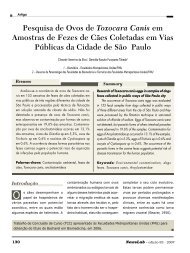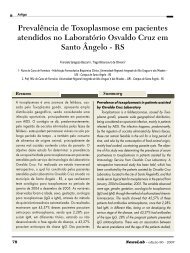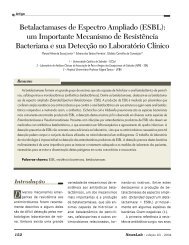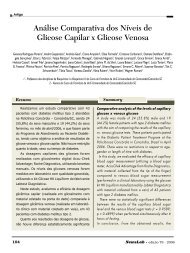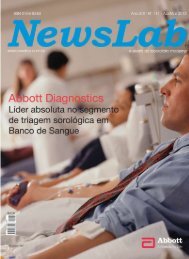Avaliação da Performance do Método ... - NewsLab
Avaliação da Performance do Método ... - NewsLab
Avaliação da Performance do Método ... - NewsLab
You also want an ePaper? Increase the reach of your titles
YUMPU automatically turns print PDFs into web optimized ePapers that Google loves.
corpo monoclonal específico paraca<strong>da</strong> analito há um deriva<strong>do</strong> <strong>do</strong>analito marca<strong>do</strong> com complexode rutênio, o qual compete diretamentecom o analito <strong>da</strong>amostra <strong>do</strong> paciente testa<strong>da</strong>pelo sítio <strong>do</strong> anticorpo marca<strong>do</strong>.O tempo de incubação é de18 minutos.de soros, duas vezes ao dia durante10 dias.• Cálculo <strong>do</strong>s Erros: o coeficientede variação (CV) foi calcula<strong>do</strong>através <strong>do</strong> programas Excele Controle de Quali<strong>da</strong>de <strong>da</strong>Biosystems.• Avaliação <strong>do</strong> CIQ: o CIQ foijulga<strong>do</strong> pelo estu<strong>do</strong> <strong>do</strong>s gráficosde Levey-Jennings e pela aplicação<strong>da</strong>s regras de Westgard.• Julgamento <strong>do</strong> méto<strong>do</strong>: comparação<strong>do</strong>s CV encontra<strong>do</strong>s através<strong>do</strong>s testes de r e R com aquelesforneci<strong>do</strong>s pelo fabricante epelo CLIA (Clinical LaboratoryImprovement Amendments).Resulta<strong>do</strong>sA Tabela 1 apresenta os <strong>da</strong><strong>do</strong>srelativos ao estu<strong>do</strong> <strong>do</strong>s coeficientesde variação (CV’s) encontra<strong>do</strong>spara os testes de repetibili<strong>da</strong>dee reprodutibili<strong>da</strong>deem comparação com os coeficientesde variação forneci<strong>do</strong>spelo fabricante e pelo CLIA.Como pode ser observa<strong>do</strong>, apenaso analito CEA apresentoupara a reprodutibili<strong>da</strong>de CV maiorque a referência defini<strong>da</strong> pelofabricante, fican<strong>do</strong> de acor<strong>do</strong>com o CV <strong>do</strong> CLIA.A Tabela 2 demonstra oacompanhamento <strong>do</strong>s controlesinternos (Biorad <strong>do</strong>is níveis)durante os testes de reprodutibili<strong>da</strong>dee repetibili<strong>da</strong>de. To<strong>do</strong>sos valores foram avalia<strong>do</strong>s aplican<strong>do</strong>as regras de Westgardpré-estabeleci<strong>da</strong>s pelo laboratórioatravés <strong>do</strong> gráfico de Levey-Jennings.Tabela 1. Comparação <strong>do</strong>s coeficientes de variação entre repetibili<strong>da</strong>dee reprodutibili<strong>da</strong>de <strong>do</strong>s marca<strong>do</strong>res tumorais com os forneci<strong>do</strong>s pelofabricante e pelo CLIA.Testes CV CV CV CV biológicaRepetibili<strong>da</strong>de Reprodu- de reprodu- <strong>do</strong> CLIA(%) tibili<strong>da</strong>de tibili<strong>da</strong>de (%)(%) forneci<strong>do</strong> pelofabricante(%)Protocolo <strong>do</strong> estu<strong>do</strong>• Repetibili<strong>da</strong>de (r): para estaavaliação foi <strong>do</strong>sa<strong>do</strong> um pool desoros no mesmo dia por 20 vezespara ca<strong>da</strong> analito.• Reprodutibili<strong>da</strong>de (R): paraesta avaliação foi <strong>do</strong>sa<strong>do</strong> um poolCEA 4,0 8,0 5,4 12,7AFP 1,2 3,0 3,1 12CA15-3 3,0 3,8 4,3 5,7CA125 2,6 3,4 4,2 29,2CA19-9 2,0 8,0 8,0 24,5ß-HCG 1,8 2,0 2,3 -Prolactina 1,35 3,2 4,4 6,9168<strong>NewsLab</strong> - edição 72 - 2005
Tabela 2. Valores <strong>do</strong>s Controles Internos de Quali<strong>da</strong>de (Biorad <strong>do</strong>is níveis) para alguns marca<strong>do</strong>res tumoraisTestes 1 2 3 4 5Lyphochek Lyphochek Lyphochek Lyphochek Lyphochek Lyphochek Lyphochek Lyphochek Lyphochek Lyphochek1 2 1 2 1 2 1 2 1 2(Normal) (Baixo) (Normal) (Baixo) (Normal) (Baixo) (Normal) (Baixo) (Normal) (Baixo)CEA 5.34 39 5,24 38 5,64 40,8 5,3 39,4 5,38 40AFP 18 80 17 78 17,7 79,8 17,6 75,5 17,8 81,5CA15-3 14,5 46 14,2 45,5 14,7 48,8 14 46 14,8 48,4CA125 30 74 29 76 31,5 78,5 30 76 30,9 77,2CA19-9 9,4 35,8 9,7 34 9,8 35,4 9,4 34,6 9,8 34,8ß-HCG 8,6 20 7,5 21,2 8,6 22 7,6 21,8 8,1 19,2Prolactina 8,2 21 8,4 20,6 8,35 21,2 8,1 19,8 9,0 20Testes 6 7 8 9 10Lyphochek Lyphochek Lyphochek Lyphochek Lyphochek Lyphochek Lyphochek Lyphochek Lyphochek Lyphochek1 2 1 2 1 2 1 2 1 2(Normal) (Baixo) (Normal) (Baixo) (Normal) (Baixo) (Normal) (Baixo) (Normal) (Baixo)CEA 5,7 42,4 5,8 43,4 5,2 42 5,7 39,6 5,5 43AFP 18,2 81,3 18,7 84,8 19 82 17,6 80,2 18 84,8CA15-3 14,5 49 15,5 48,5 14,6 47 14,7 46,9 14,5 48CA125 30,4 76 32,7 80,1 31 79 30,7 75,4 31,2 76,2CA19-9 9,6 35,8 9,9 36,8 8,7 35,5 9,9 34,9 9,7 35,5ß-HCG 8,3 19,5 7,6 21 8,9 20,1 7,6 20,9 7,9 20,5Prolactina 9,1 20,5 8,9 19,6 8,7 19,9 8,6 19,6 8,9 20,8*Valores referenciais para o Lyphochek 1: CEA: 4,2-6,8 ng/mL; AFP: 15-24 IU/mL; Ca 15-3: 10,1- 18,8 U/mL; CA 125: 23-36 U/mL; CA 19-9: 6,9-11,9 U/mL; ß-HCG:5,36-10,64 mIU/mL; Prolactina:6,75-11,25 ng/mLValores referenciais para o Lyphochek 2: CEA: 33,3-51,1 ng/mL; AFP: 68-112 IU/mL; Ca 15-3:36,3- 67,5 U/mL; CA 125: 62-94 U/mL; CA 19-9: 28-43 U/mL; ß-HCG:16,17-25,83mIU/mL;Prolactina:16,34-26,66ng/mLDiscussãoO CLIA (Clinical LaboratoryImprovement Amendments) determinaque o laboratório avalie odesempenho de ca<strong>da</strong> novo méto<strong>do</strong>.Estima-se a precisão (CV) e aexatidão (tendenciosi<strong>da</strong>de) <strong>do</strong>méto<strong>do</strong> por ensaios de vali<strong>da</strong>çãode méto<strong>do</strong>s. Para os méto<strong>do</strong>s jáexistentes, os resulta<strong>do</strong>s <strong>do</strong>s materiaisde controle que estão sen<strong>do</strong>analisa<strong>do</strong>s atualmente em laboratóriospoderão ser usa<strong>do</strong>spara avaliar os CV’s <strong>do</strong>s méto<strong>do</strong>s.Os resulta<strong>do</strong>s oriun<strong>do</strong>s <strong>do</strong> ensaiode proficiência ou estu<strong>do</strong>s de comparaçõespoderão ser usa<strong>do</strong>s paraavaliar a tendenciosi<strong>da</strong>de (6).O aparecimento de novos méto<strong>do</strong>sfacilitou a execução em larga<strong>NewsLab</strong> - edição 72 - 2005169
escala de novos testes específicos,propician<strong>do</strong> a massificação <strong>do</strong>s resulta<strong>do</strong>sem aparelhos automáticose retiran<strong>do</strong> a possibili<strong>da</strong>de de umexame mais cui<strong>da</strong><strong>do</strong>so para ca<strong>da</strong>caso. Como exemplo disso têmseos marca<strong>do</strong>res tumorais que sãosubstâncias encontra<strong>da</strong>s no sangue,urina ou teci<strong>do</strong>s de pessoas comcertos tipos de câncer. A maioria sãoproteínas ou pe<strong>da</strong>ços de proteínas.E são produzi<strong>do</strong>s pelo próprio tumorou pelo organismo como resposta àpresença <strong>do</strong> câncer (9).A seleção <strong>do</strong> méto<strong>do</strong> mais adequa<strong>do</strong>é uma <strong>da</strong>s grandes responsabili<strong>da</strong>des<strong>do</strong> patologista, visan<strong>do</strong>à maior reprodutibili<strong>da</strong>de <strong>do</strong>s resulta<strong>do</strong>spor meio de procedimentosmais padroniza<strong>do</strong>s e, sempreque possível, tornan<strong>do</strong> mais simplesas reações. Isto requer conhecimento,experiência e atenção continua<strong>da</strong>de to<strong>da</strong> a equipe (8).Dois aspectos importantes devemser lembra<strong>do</strong>s: o primeiro éconhecer o quanto o teste é bomna detecção de pacientes realmente<strong>do</strong>entes, ou seja, sua sensibili<strong>da</strong>de.Se um teste é muito sensível,ele tem uma baixa proporçãode resulta<strong>do</strong>s falsos-negativos. Osegun<strong>do</strong> aspecto <strong>da</strong> vali<strong>da</strong>de deum teste é sua capaci<strong>da</strong>de de identificarcorretamente a ausência de<strong>do</strong>ença, ou seja, sua especifici<strong>da</strong>de.Se um teste é muito específico,ele tem uma baixa proporçãode resulta<strong>do</strong>s falsos-positivos (5).Para a vali<strong>da</strong>ção <strong>do</strong> méto<strong>do</strong> diagnóstico,<strong>do</strong>is aspectos devem serobserva<strong>do</strong>s: repetibili<strong>da</strong>de e reprodutibili<strong>da</strong>de.Reprodutibili<strong>da</strong>de ouprecisão é avalia<strong>da</strong> pela comparação<strong>do</strong>s resulta<strong>do</strong>s de medi<strong>da</strong>s repeti<strong>da</strong>sde um mesmo objeto (10).Reprodutibili<strong>da</strong>de diz respeito àconsistência ou concordância deresulta<strong>do</strong>s quan<strong>do</strong> o exame se repete,em condições idênticas (11,12). Repetibili<strong>da</strong>de (r) demonstraa diferença máxima permiti<strong>da</strong> entremedi<strong>da</strong>s obti<strong>da</strong>s no mesmo dia,diferente <strong>da</strong> reprodutibili<strong>da</strong>de (R)que mostra essa diferença em diasdistintos (4).Controle Interno, ou material dereferência, visa identificar e eliminarerros, inerentes ao processodiário e garantir a repetibili<strong>da</strong>de<strong>do</strong>s resulta<strong>do</strong>s, por isso devem serusa<strong>do</strong>s com freqüência diária (7).Referências BibliográficasOs controles internos realiza<strong>do</strong>sdurante o estu<strong>do</strong> foram analisa<strong>do</strong>santes de iniciar as <strong>do</strong>sagens<strong>do</strong> dia e se mostraram de acor<strong>do</strong>com as regras de Westgard préestabeleci<strong>da</strong>spelo laboratório (6).ConclusãoAs análises de repetibili<strong>da</strong>de ereprodutibili<strong>da</strong>de para vali<strong>da</strong>ção <strong>da</strong>meto<strong>do</strong>logia ECLIA (Roche) foramrealiza<strong>da</strong>s de acor<strong>do</strong> com o CLIA edemonstraram um excelente desempenhopara os testes de algunsmarca<strong>do</strong>res tumorais, sen<strong>do</strong> aprova<strong>do</strong>spara a rotina <strong>do</strong> LaboratórioDalmo Oliveira, Recife - PE.Correspondências para:<strong>da</strong>lmoli@veloxmail.com.br1. (http://andre.sasse.com/cancer.htm)- Julho/2004.2. (http://www.inca.gov.br/)- Julho/2004.3. (http://planeta.terra.com.br/saude/prevican/monito.html)- Agosto/2004.4. (http://allchemy.iq.usp/alfa)- Agosto/2004.5. Dawson-Saunders e TRAPP, 1994.6. http://www.control-lab.com.br/pdf/westgard_melhores_praticas.pdf-Agosto 2004.7. (http://www.control-lab.com.br/controleinterno_clinico.htm)-Setembro 2004.8. Alves VAF, Leandro LO, Vassallo J, Pereira EM, Kanamura CT, Wakamatsu A, SantosRTM, Nonogaki S. Interlaboratorial quality-control in immunohistochemistry: cytokeratinsand estrogen receptors as models. Jornal Brasileiro de Patologia Medica eLaboratorial, 40(3). Rio de Janeiro, 2004.9. www.<strong>da</strong>ycare.com.br/marca<strong>do</strong>res_tumorais.shtml.10. Mausner JS, Kramer RS. Epidemiology: an introductory text. 2.ed. 1985, 361p.Chapter 9: Screening in the detection of disease, p.214-238.11. Pereira CLS et al. Relação entre índice de higiene oral e classificação social emcrianças <strong>do</strong> programa de assistência o<strong>do</strong>ntopediátrica integral continua<strong>da</strong>. Arq. CentroEst. Curso O<strong>do</strong>nt., Belo Horizonte, 31 (1-2): 47, jan./dez. 1995.12. Pereira MG. Epidemiologia: teoria e prática. Rio de Janeiro: Guanabara Koogan,1995. 594 p. Cap.17: Aferição <strong>do</strong>s eventos, p. 358-376.170<strong>NewsLab</strong> - edição 72 - 2005


